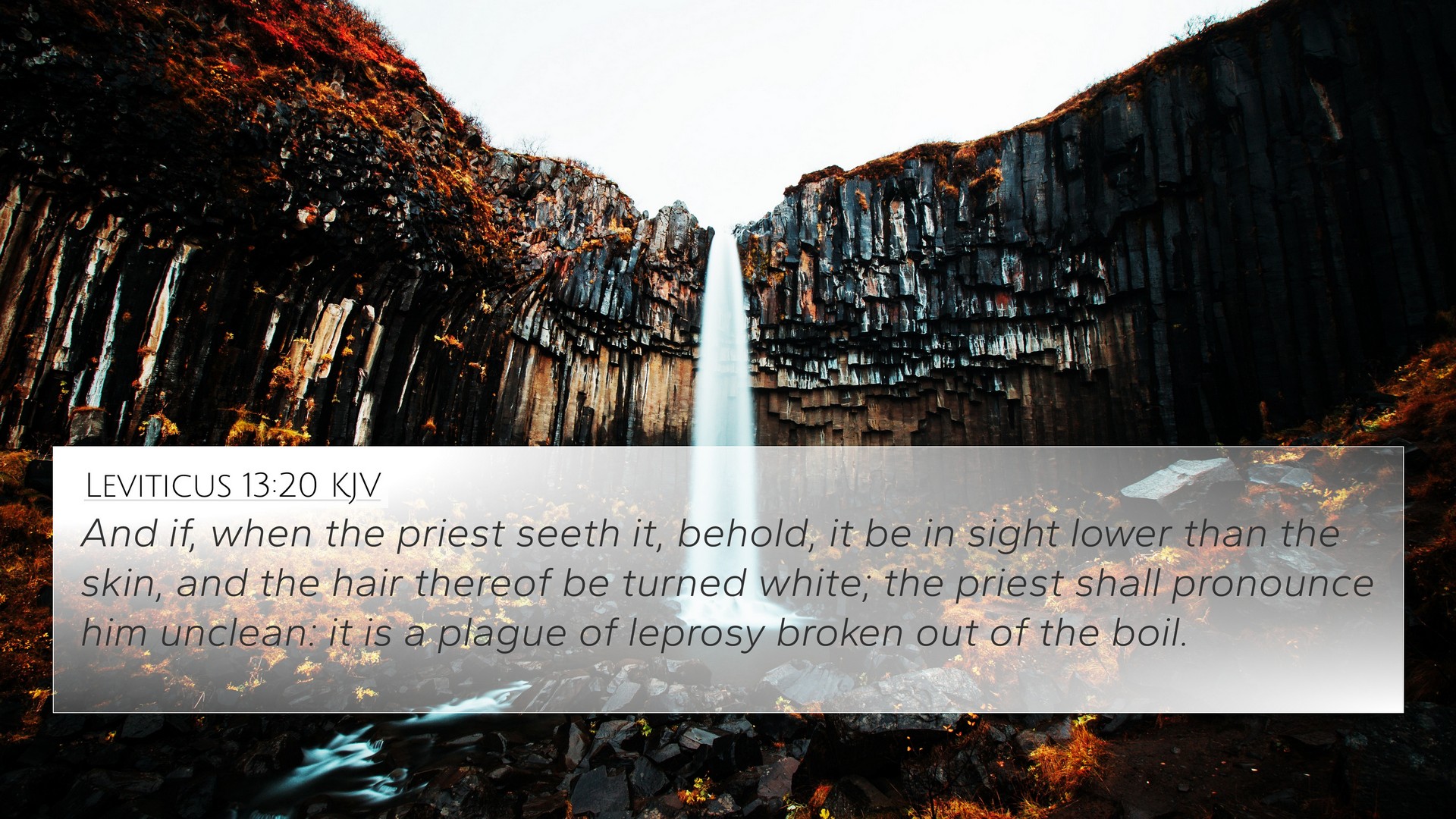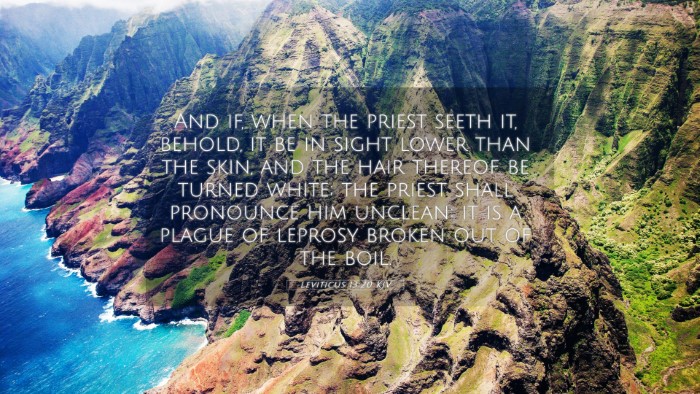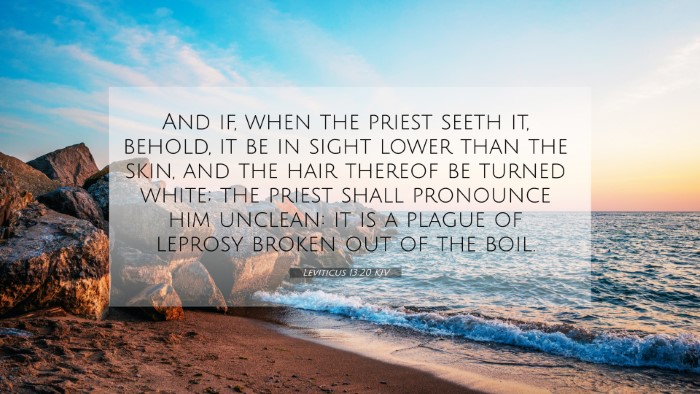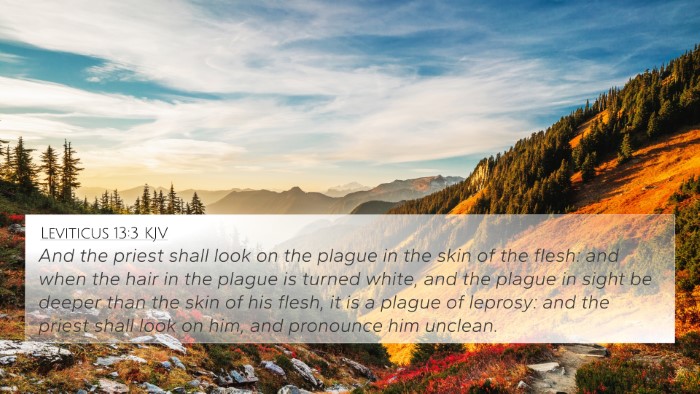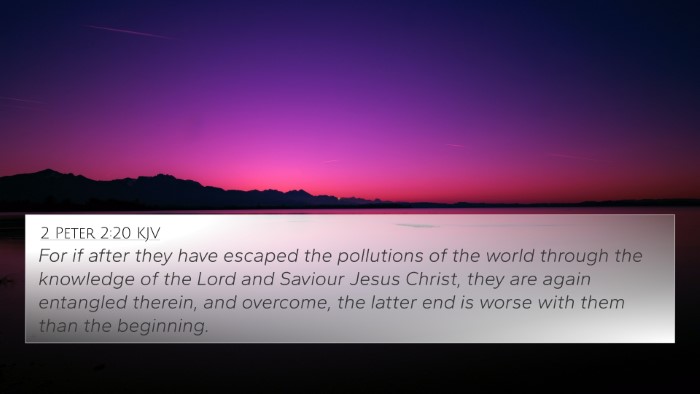Bible Verse Interpretation: Leviticus 13:20
Leviticus 13:20: "And if, when the priest seeth it, behold, it be in sight lower than the skin, and the hair thereof be turned white; the priest shall pronounce him unclean: it is a plague of leprosy broken out of the boil."
Summary of Meaning
This verse addresses the diagnosis of skin diseases, specifically leprosy, which is treated with great care in the Law of Moses. In this case, it underscores the role of the priest in making judgments regarding cleanliness and disease, which were vital for maintaining both physical health and spiritual purity among the Israelites.
Insights from Public Domain Commentaries
-
Matthew Henry:
Henry emphasizes the responsibility of the priest in examining the afflicted individual. The 'sight lower than the skin' signifies a more severe condition than the exterior visible symptoms, highlighting the importance of discerning not just surface issues but underlying spiritual implications as well.
-
Albert Barnes:
Barnes notes that the whiteness of the hair signifies the seriousness of the condition. It symbolizes the defilement and the necessity for the individual to be declared unclean, thereby enforcing the community's boundaries concerning purity and health.
-
Adam Clarke:
Clarke highlights both the medical and ritual aspects of leprosy. The examination process serves not only as a health check but as a spiritual examination, illustrating the connection between physical health and spiritual standing within the community.
Cross-References
This verse has numerous connections and themes that align with many other Biblical scriptures. Here are some significant cross-references:
- Leviticus 14:2-7: Details the purification process for individuals healed from leprosy.
- Numbers 12:10-15: The incident involving Miriam, highlighting God's judgment and the awareness of leprosy in the community.
- 2 Kings 5:1-14: The story of Naaman emphasizes God's power to heal leprosy.
- Matthew 8:2-4: Jesus cleanses a leper, showing the continuity of healing from the Old to the New Testament.
- Mark 1:40-45: Another account of Jesus healing a leper, illustrating messianic authority over disease.
- Luke 5:12-16: Demonstrates the compassion of Christ towards lepers, fulfilling the Law's requirements.
- Hebrews 13:12-13: Reflects on Jesus suffering outside the camp, tying spiritual and physical cleansing with sacrifice.
Connections Between Bible Verses
The examination of Leviticus 13:20 shows how the themes of purity, disease, and community health are crucial in both the Old and New Testaments. This verse serves as a starting point for understanding how both testaments dialogue about the condition of humanity:
- Spiritual Implications: The connection between physical ailments like leprosy and spiritual purity showcases the comprehensive approach to health in Scripture.
- Community Sanitation: The communal rituals surrounding illness reflect early understandings of public health that resonate in modern practices.
- Healing as a Theme: The healing narratives in the Gospels echo the purification laws found in Leviticus, demonstrating continuity in God's work through different covenants.
Thematic Bible Verse Connections
This verse establishes a foundation for 'uncleanness' in Scripture, reflected in various themes:
- Purity Laws: The detailed laws of purification serve as a precursor to understanding holiness and God's standards.
- Faith and Healing: References to leprosy link with faith narratives, emphasizing reliance on God for both physical and spiritual ailments.
- God's Mercy: Jesus' interactions with lepers highlight the compassion of God in restoring those considered unclean, showcasing the redemptive aspect of His ministry.
Scriptural Cross-Referencing Methods
To deepen your understanding and study of Leviticus 13:20 and its connections, several tools and methods can be utilized:
- Bible Concordance: A tool for locating terms and their occurrences throughout the Bible.
- Cross-Reference Bible Study: This method involves examining related verses that provide context and support the main verse.
- Bible Reference Resources: Utilize comprehensive study bibles and commentaries for deeper insights.
- Cross-Reference Bible Study Methods: Engaging in thematic studies that identify recurring motifs can enhance comprehension.
- Chain References: Following thematic links throughout the text illuminates interconnected messages.
User Intent and Explorations
To explore the richness of Leviticus 13:20, one might consider questions like:
- What verses are related to leprosy and uncleanness in the Bible?
- How do the purification laws in Leviticus connect with Jesus' healing miracles?
- Similarities between Leviticus 13 and the healing narratives in the Gospels.
- What Bible verses support the theme of spiritual purity linked to physical ailments?
Engagement with these questions can open up pathways for deeper study and reflection on the relationships between various Bible verses, enhancing your understanding of both Testaments as interconnected narratives revelatory of God's work.
